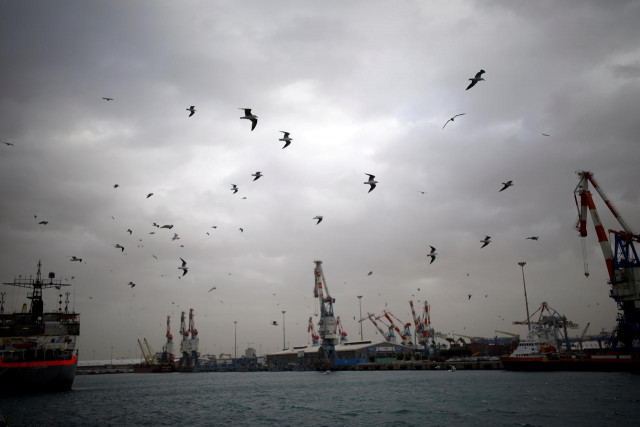Pakistan needs to focus on developing seaports
Global success of many countries depends on investment, management of seaports

Representational image. PHOTO: REUTERS
Especially, the role of seaports is vital in this regard. It is estimated that more than 90% of global trade is facilitated through seaborne shipments. Therefore, the global business success of many countries is directly tied to their investments and management of seaports.
According to a World Bank report of 2017, “Improving the competitiveness of South Asia’s container ports located in Bangladesh, India, Pakistan and Sri Lanka is critical to maintaining the trade growth in the region and fostering its fast economic growth.” With reference to neighbouring China, the economic growth of China has always been proportional and dependent on the cost-sensitive and agile functioning of its number of seaports.
This can be noted that major Chinese seaports located in Shanghai, Shenzhen, Ningbo-Zhoushan, Hong Kong, Guangzhou, and Qingdao have surpassed the trade transactions of other major ports of the world, including Singapore port, Busan port (South Korea), Jebel Ali (Dubai), Antwerp (Belgium) and Los Angeles Port (US).
For example, the Port of Shanghai with its 125 berths handles more than 2,000 container ships in a month whereas the Singapore port with its 200 cranes attracts a huge global logistics business for the country.
On the other hand, the most prominent, but the underutilised port in Pakistan, the Karachi Port handles only 1,600 ships during the whole year with 33 berths for dry and liquid cargo. A detailed analysis of Logistics Performance Indicators (LPI) reveals that in comparison to other nations, the performance of Pakistan is quite depressing, especially in the areas of customs clearance, tracking and tracing of shipments, timeliness, infrastructure, ease of getting efficient international shipments and logistics competence in terms of ease of getting third party logistics (3PLs) services.
Similarly, the overall LPI places the performance of Pakistan even lower than that of Bangladesh and Sri Lanka.
Pakistan’s major deep seaports such as Karachi Port, which accounts for around 60% of its marine shipments, Port Qasim 35% and Gwadar Port, which is currently being developed, can play an important role in reducing the country’s trade deficit if upgraded and secured.
Besides offering the shortest route to warm waters from Central Asia, the Gwadar Port, which is a gateway to the Persian Gulf at the Strait of Hormuz, has tremendous potential to become a major transit port to facilitate global shipments of dry goods and the movement of oil and gas among regional areas including the Middle East, South Asia and Central Asia.
The maritime silk route initiative and China-Pakistan Economic Corridor (CPEC) also offer prospective economic uplift for Pakistan if Gwadar Port is utilised with its full potential. Furthermore, in Gwadar, Pakistan with Chinese collaboration is developing a vocational centre, a 300-megawatt power plant, an international airport, and an expressway to link Gwadar Port with the rest of the country and its neighbours.
Recently, the Ministry of Maritime Affairs Pakistan announced that a German firm had expressed interest in investing $40 million in Bin Qasim’s upgrade and the Economic Coordination Committee permitted the construction of LNG terminals at Port Qasim.
However, by only developing the long-awaited fundamental infrastructure, stretching the port location, developing additional berths and terminals, dredging to facilitate larger ships and offering special economic and industrial zones is not simply enough to reach the status of a competitive international transit hub.
In comparison to Singapore Port, Jebel Ali Port in Dubai, Salalah Port in Oman, the World Bank report indicates, the operational costs including tariffs and terminal handling charges at most big South Asian container ports are lower, yet their indirect costs associated with delays and uncertainty had an immense effect on customer choices.
Therefore, the government of Pakistan needs to focus on providing smart solutions to all its seaports in terms of improving and monitoring port infrastructure, optimising cargo handling, automating customs clearance, encouraging intermodal transportation services, improving port and cargo safety and adopting eco-friendly initiatives to reduce the use of energy and avoid costly oil spills.
In light of observations made in the World Bank’s LPI scorecard, the most effective way to achieve improvements at ports is the adoption of the latest technology.
The use of marine drones to help inspect ships and port condition under water, 3D imaging technology to expedite a reliable container inspection process, automation ie automatic cranes to increase smooth handling of cargo, digital dashboards to reduce waiting times by improving communications among cargo ships, port operators and handlers can help improve performance.
Similarly, the use of blockchain technology will also aid in improving the security and transparency of transactions. As the world is witnessing a major shift of economic boom from the West to the East, the accompanying logistics gain is low-hanging fruit for Pakistan by developing and, more importantly, implementing and further developing the infrastructure-related goals, which will speed up economic recovery of the nation.
Finally, according to a World Bank report of 2017, if every South Asian container port performed as efficient as the regions best, the maritime transport costs for South Asian exports would decrease by up to 8.8% and exports would increase by up to 7%.
The writer is a faculty member at the King Fahd University of Petroleum and Minerals and specialises in supply chain management
Published in The Express Tribune, September 2nd, 2019.
Like Business on Facebook, follow @TribuneBiz on Twitter to stay informed and join in the conversation.




1735506669-0/image-(16)1735506669-0-208x130.webp)














COMMENTS
Comments are moderated and generally will be posted if they are on-topic and not abusive.
For more information, please see our Comments FAQ